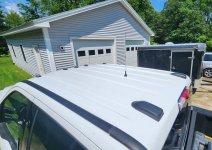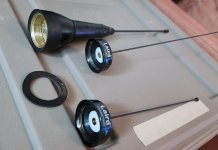mmckenna
I ♥ Ø
Backer plate may have been an option, but if the Chief is happy with a fender mount, go with it.
In the meantime, I may just use a fender/hood mount bracket. Will I be OK using a 1/4 wave antenna at that position even though the ground plane is also less than ideal at that location?
I'm not too keen on buying 1/2 wave 'no ground plane' antennas as that extra expenditure (when I prefer 1/4 waves anyway) was a major turn-off for the BPD third brake light mount in the first place.

So far, so good.
The install was easy with my Laird 3/4" drill - just scary while you're doing it.
I pulled the LMR-200 (pre-attached to the Larsen NMO mount) across the headliner over the airbags and down the B-pillar with fish tape. I left the coil of coax poking out of the bottom of the pillar as I haven't yet terminated it nor do I have a radio installed.
I'll probably put a BNC connector on for initial use with handhelds and will then run DC power from the battery into the cabin for either my TYT TH9800 or Yaesu FTM-3100R (via BNC to UHF-Male adapter) - haven't decided if I need dual (quad) band or just VHF.
The Tram 11181 antenna in the picture is a decent performer for the upper end of amateur VHF and into low business frequencies / scanning. Not great quality and usually prefer a trimmed/tuned monoband 1/4 wave.
View attachment 144981

I have a similar antenna on one of my cars as I wanted as wide a bandwidth as possible. The NMO retaining ring has a sealing o-ring in it, providing weatherproofing of the mount. The flat rubber washing provides additional sealing and a bearing surface between the antenna and the car body. I do PM work on the mount annually and have a bunch of those rubber washers. I replace the washer during that PM time.To be clear, the mount itself is a Larsen NMOKHF200 (LMR200 coax, non-terminated).
I have found this Tram antenna to have particularly wide bandwidth on VHF. But it's a hassle (also with the Laird 1/4 waves in picture below) to have to use the additional large O-ring to seal around the base of the antenna.
Is the rubber-sealed-base style of antenna (like the EMWave, also pictured) inherently better?
View attachment 145251
To be clear, the mount itself is a Larsen NMOKHF200 (LMR200 coax, non-terminated).
I have found this Tram antenna to have particularly wide bandwidth on VHF. But it's a hassle (also with the Laird 1/4 waves in picture below) to have to use the additional large O-ring to seal around the base of the antenna.
Is the rubber-sealed-base style of antenna (like the EMWave, also pictured) inherently better?
View attachment 145251
I've never used the chrome based ones, only the plastic based ones. (As shown in the OP's photo) Is the leaking you've mentioned coming from under the base or through the radiator/cap connection? Just curious.The 1/4 wave antenna should give you lots of useable bandwidth, and it shouldn't matter which brand it is.
I've found that those chrome nut type NMO antennas eventually let a bit of moisture in. I've had to replace a few mounts where they were not getting checked frequently and the moisture caused some corrosion.
The EM Wave base design is one of the best in the industry, I think, and I've started using them on my personal vehicles as well as some applications at work. I've been running several of their antennas for a few years now, and haven't had any issues at all with them.
The Larsen NMO mounts with the polymer base have an excellent sealing design, also. I've been running those for 30+ years now without any issues. Larsen NMOQC 136-512 MHz Field Tunable Two Way Radio Antenna NMO Mount
You won't go wrong with either one.
I've never used the chrome based ones, only the plastic based ones. (As shown in the OP's photo) Is the leaking you've mentioned coming from under the base or through the radiator/cap connection? Just curious.
Okay, that makes sense and that's about the only place I would expect them to leak. I come across them periodically but have never noticed a major problem with them. Most of my mobile fleet is my own so as such it's much smaller and easier to work on. Swapping the gaskets annually has eliminated any potential problems. I usually do it when the car get a clean and wax. The gasket is the easy part.The chrome nut style, like these:
Larsen NMOQSPEC 144-512 MHz Field Tunable Two Way Radio Antenna NMO Mount
Field tunable quarterwave antenna, 144-512 MHz Antenna, Chrome, Gain (dB) Unity, Maximum Power 200(Watts), Whip Length 22"theantennafarm.com
I think over the years, the flexing of the whip results in a bit of a gap between the whip and the seal. Water drips down the whip and eventually gets between the antenna and the NMO mount. I've had them do that even with the rubber disk gasket.
I stopped using them at work as replacing the NMO mount can take some time. Even if you reuse the coax, having enough slack to strip and solder the connection takes time. Haven't had the issue since I switched to the Larsen polymer base antennas.
Might absolutely have something to do with where I am, close enough to the ocean that it could be a bit of salt water getting in there.
I do try to PM the antennas, but it's difficult to get to all the vehicles sometimes.
Okay, that makes sense and that's about the only place I would expect them to leak. I come across them periodically but have never noticed a major problem with them. Most of my mobile fleet is my own so as such it's much smaller and easier to work on. Swapping the gaskets annually has eliminated any potential problems. I usually do it when the car get a clean and wax. The gasket is the easy part.
Yeah, I don't expect you can rely on the vehicle operators to tend to it. We are almost exclusively HTs at work. I've lost track of the number of times someone brings a non working HT with an antenna that doesn't go to the radio. I have no idea where they even get them but well, that's a different topic altogether,I make a point of removing my antennas periodically and inspecting/cleaning them.
At work, it's a bit harder, but I do it when I can. With the better NMO bases, it's reduced the number of issues I run across.
Yeah, I don't expect you can rely on the vehicle operators to tend to it. We are almost exclusively HTs at work. I've lost track of the number of times someone brings a non working HT with an antenna that doesn't go to the radio. I have no idea where they even get them but well, that's a different topic altogether,
Yeah, I don't expect you can rely on the vehicle operators to tend to it. We are almost exclusively HTs at work. I've lost track of the number of times someone brings a non working HT with an antenna that doesn't go to the radio. I have no idea where they even get them but well, that's a different topic altogether,
The end user sabotage stories are worthy of their own thread. I expect it would be a long one.Yeah, it's amazing what the end users can do:
1) Trash company, on an 800 SMR, drivers always complaining about range, coverage. But some drivers had buddies who 'did CBs' and told them the longer the antenna the better it will work. So drivers would toss the 800 MHz gain antenna and replace it with a CB whip.
2) Water tank contractor is up on top, muni asks them to look at the SCADA antenna, 'cuz the 900 MHz PTP link keeps dropping. Crew sees an abandoned DB-224 VHF, swaps line over to that. Doesn't understand why it's no better. Does Muni water operator call a real radio shop? NO!!!!!
To quote Dave Barry "I am not making this up!"
I'm game for that.The end user sabotage stories are worthy of their own thread. I expect it would be a long one.

